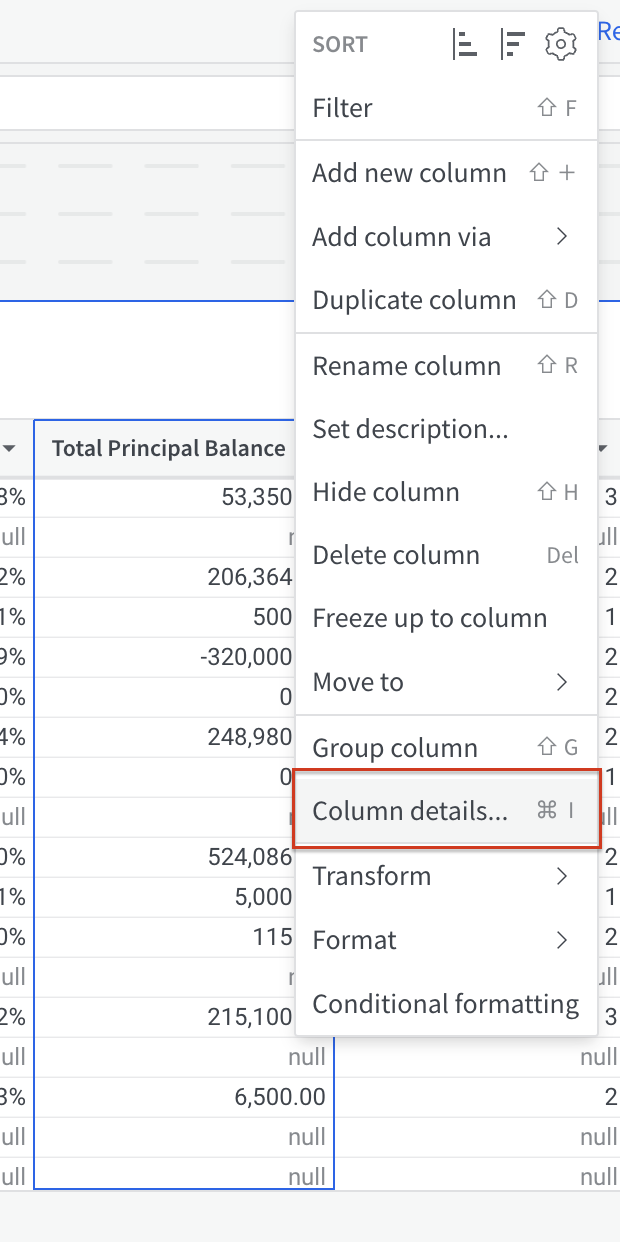Data type and format support
Built supports various data types and formats to facilitate effective analysis and reporting. Data formats enable you to display the data in a clear and meaningful way.
This document defines the supported data types and provides an overview of data type formats and constraints.
Built data types
Built supports the following data types:

|
Text | Strings of characters that represent textual information |

|
Number | Numerical digits that represent numeric values or quantitative information |

|
Date | Date values that represents specific periods or points in time |

|
Logical | Boolean values (true or false) that represent binary or conditional states |
|
|
Semi-structured data that represents one or more values of other data types |
|
|
|
Spatial data that represents geographic locations or features |
You can identify column data types in workbooks by referencing the icons in the Element properties > Columns list or the Column details modal.

Text
The text data type supports unstructured strings of characters (letters, numbers, symbols, and spaces) that represent textual information.
Number
The number data type supports structured numeric digits that represent numeric values or quantitative information.
Integers cast to int64 and can present up to 19 digits of precision, while fixed-point decimals and floating-point numbers cast to float64 and present 15-17 significant digits.
Note: When you need to display precise number values that exceed the maximum number of digits and don't require mathematical operations (for example, account numbers, serial numbers, or other identifiers), convert the column values to text strings using the Text function.
Number formats
Number data can be displayed in the following formats:
| Format | Example |
|---|---|
| Plain text | 1234.56 |
| Number | 1,234.56 |
| Percent | 12.34% |
| Scientific | 1.23e4 |
| SI units | 1.2k |
| Currency | $1234.56 |
| Financial | (1,234.56) |
| Whole number | 1,234 |
You can also configure custom number formats based on the d3-format module.

Date
The date data type supports structured date values that represent specific points in time.
Built presents date and time relative to your default time zone. To display the data in a different time zone, use the ConvertTimezone function.
For a list of functions provided to operate on date data, see Date functions overview.
Date formats
Date data can be displayed in the following formats:
| Format | Example |
|---|---|
| Date | 01/31/2023 |
| ISO date | 2023-01-31 |
| Long date | January 31, 2023 |
| Month year | Jan 2023 |
| Date time | 01/31/2023 03:04:05 PM |
| ISO date time | 2023-01-31 15:05:05 |
| Time | 03:04 PM |
You can also configure custom date formats. For more information, see Define custom date formats.

Logical
The logical data type supports structured Boolean values (true or false) that represent binary or conditional states.
Logical formats
Logical data can be displayed in the following formats:
| Format | Example |
|---|---|
| Boolean |
true false |
Variant
The variant data type supports semi-structured data that represents one or more values of other data types, including text, number, and date.
Variant formats
Variant data can be displayed in the following formats:
| Format | Example |
|---|---|
| JSON | {"name":"Alex Lee","age":30,"email":"alex@example.com"} |
| GeoJSON | {"type":"Feature","geometry":{"type":"Point","coordinates":[-73.98, 40.74]},"properties":{"name":"Empire State Building","category":"Landmark"}} |


